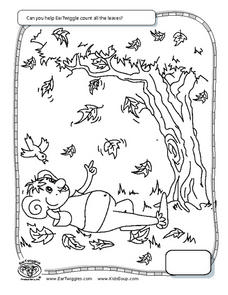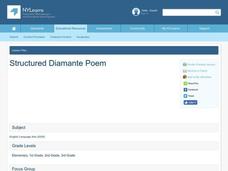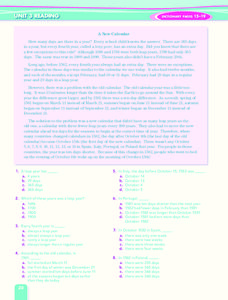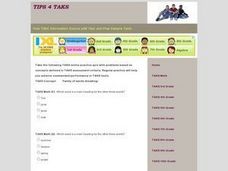Curated OER
EarTwiggle
In this counting leaves worksheet, students assist EarTwiggle in counting all the leaves found within a piece of art and then place their answer in the box provided at the lower right hand corner.
Curated OER
Phrases and Clauses Recognition
In this identifying phrases and clauses worksheet, students read definitions and examples and use them to determine the identify of the groups of words in the review. Students write 15 answers.
Curated OER
Vital Work
Students consider the role of women in the food industry. In this gender exploitation lesson, students work in groups to examine unfair labor practices. Students watch a video and write a fictional letter from a female laborer. This...
Curated OER
Apparent Motion of the Sun
Demonstrate the path of the sun across the sky at different times of the year with an engaging science lesson. Learners use a series of questions and diagrams to examine the movement of the sun and appearance of the sky around their...
Curated OER
Structured Diamante Poem
Youngsters review nouns, adjectives and verbs. In this poetry lesson, readers choose a set of antonyms and create a list of synonyms, verbs and adjective for each. Students use the words to write a Diamante poem.
Curated OER
The Learning Network: Alligators Everywhere Fill-In
Meant to be used with the article, "In Florida, the Natives Are Restless" (included here), this is a great source of high-interest, nonfiction reading. A fill in the blank vocabulary activity and an activity focusing on reading...
K12 Reader
Chaparral Ecosystems
Explore the impact of wildfires with a reading passage about ecosystems. Pupils read the passage and respond to five questions related to the content of the text.
K12 Reader
Taiga Ecosystems
Introduce your class to another type of ecosystem, the taiga ecosystem, through a reading passage. Class members read the text and then respond to five reading questions about the content of the passage.
Pearson Longman
A New Calendar
The year 1582 was a very strange year. That year there was no October 5, 6, 7, 8, 9, 10, 11, 12, 13, or 14. Kids find out why when they read this short comprehension worksheet with a passage about the new calendar instituted in 1582.
National External Diploma Program Council
Capitalization Review
Using correct grammar is a capital idea! Elementary readers review the rules of capitalization, including proper nouns, abbreviations of organizations, and holidays, before correcting the errors in two sets of sentences.
PBS
The Cat in the Hat Activity Exploring Weather
Observe different types of weather right in your classroom! Here, pupils look at clouds, rain, snow, wind, and hot and cold temperatures, and observe these weather patterns at school. They keep track of their observations in a worksheet...
K5 Learning
Survival in the Wild
How do animals survive in the wild? Read about the different adaptations such as camouflage and self-protection that animals use to survive.
Beyond Benign
Daphnia Bioassay LD50
De-icing materials may have a harmful effect on our environment; have your class perform an experiment to test the nature of these effects. Scholars monitor the survival rate of a sample of daphnia as the concentration of a de-icing...
CCSS Math Activities
Out of the Swimming Pool
Out of the swimming pool and into the math classroom! Young mathematicians analyze two linear functions representing the number of liters of water in a pool as it drains over time. They must evaluate functions, interpret function...
National Park Service
Weather Patterns of the Pacific Ocean
How do oceans affect weather patterns? Learners define vocabulary associated with dew point, topographical lifting, condensation, and formation of clouds and precipitation as they explore the weather in the Pacific Northwest. They also...
Curated OER
Rice Wreaths
Students create rice and glue holiday wreaths in this Art lesson ideal for the 1st or 2nd grade. The lesson can be adapted for older or younger students and includes an ingredient list and step-by-step directions for siccessful...
Curated OER
Classifying Dog Breeds
Students classify dog breeds. In this animal science lesson, students research various breeds of dogs on the Internet and classify breeds into small, medium, and large breeds. Students illustrate their classification notes with pictures.
Curated OER
Learning About Hurricanes
Students write a research paper on hurricanes. In this weather lesson, students use a science text book to write down facts about hurricanes on note cards and then outline their essay. Students use the outline to create an organized essay.
Curated OER
T-Shirt Glyph
Students create a glyph (a symbol or icon) that represents who they are, and read the glyphs of others to explain the glyphs' data.
Curated OER
1st Grade - Act. 03: T-Shirt Glyph
First graders create glyphs (symbols or icons) which represents them, and read the glyphs of others using a legend to explain the data on the glyphs.
Curated OER
Santa Countdown Calendar
Students draw Santa's face on white paper, add color construction paper for his hat, and use the beard section for a "countdown calender" until the end of the month in this creative December activity. Each day another cotton ball is...
Curated OER
Sunset Silhouettes
Students create "SUNSET SILHOUETTES" using primary colors, black construction paper, and glue in this elementary-level Art lesson. The lesson extension included with this lesson involves creating a nativity scene and might be...
Curated OER
Family Of Words (Heading)
In this on-line language arts learning exercise, students complete 10 multiple choice questions where they choose the word that would be suitable as the main heading for other words listed below it. Students can check their answers at...

























